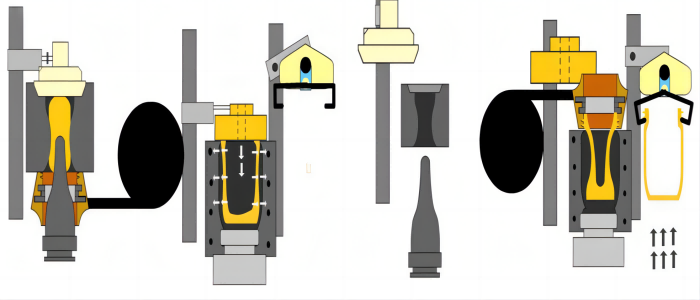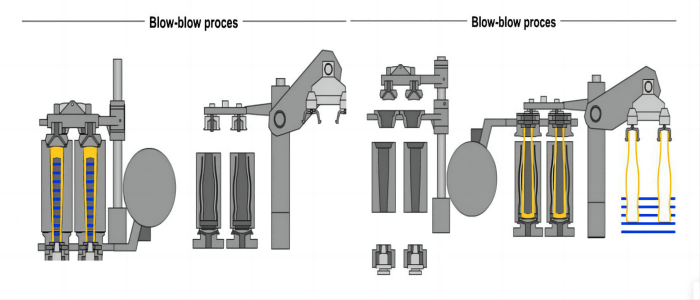Glass bottles are the main packaging containers for the food, pharmaceutical, and chemical industries. They are chemically stable, easy to seal, airtight, transparent, allowing for observation of the contents, and possess a certain mechanical strength, making them capable of withstanding the internal pressure of the bottle and external forces during transportation. They are also widely available, low-cost, and possess other advantages. So, do you know how glass bottles are made?

Preparation of Glass Raw Materials
Soda-lime glass raw materials make up the majority (about 90%) of glass products and are primarily composed of silica, with calcium oxide and lime each accounting for about 10%. Small amounts of aluminum oxide, iron oxide, barium oxide, sulfur trioxide, and magnesium oxide also make up about 5% of soda-lime glass.
Prior to melting, crushed glass (recycled glass) is added to the raw materials, comprising 15% to 50% of the final glass composition.
Crushed glass, which is generated from manufacturing waste or recycling centers, can save 1,300 pounds of sand, 410 pounds of soda ash, and 380 pounds of limestone per ton of glass recycled. This helps to reduce production costs, save resources and energy, and allows customers to obtain our products at an economical price.
Other elements are also added to the glass before melting to achieve various colors.
The amber color of glass bottles comes from nickel, sulfur, and carbon, although natural impurities in sand can also cause this color.
Other colors can be achieved by adding different materials:
- Black: iron, although it can also include magnesium oxide, copper, and carbon.
- Purple and red: manganese oxide or nickel oxide.
- Blue: copper oxide and cobalt oxide.
- Sapphire (can vary between blue and green): naturally occurring iron or added iron. Blue-green can also be obtained by mixing cobalt and chromium.
- Green: iron, chromium, and copper. Zinc oxide can produce yellow-green.
- Opaque white glass: tin, zinc oxide, calcium, fluoride, or phosphate.
Glass Melting
Crushed raw materials (silica sand, soda ash, limestone, feldspar, etc.) are ground into powder, and wet materials are dried. Iron-containing materials are de-ironed to ensure glass quality. Glass batches are then placed in a furnace for melting.
Put the glass batch into the furnace for melting
The raw materials and broken glass are continuously melted at high temperature, at around 1650°C. The furnace operates 24 hours a day, and it takes approximately 24 hours for the mixture of raw materials to form molten glass. The molten glass is then fed through a channel and cut into blocks at the end of the channel according to a precise temperature setting.
Control temperature, time, and chemical formula to ensure the uniformity of glass composition.

Glass Container Manufacturing
There are two methods of forming glass containers: blow and blow or press and blow, which are performed on IS machines.
Press and blow glass bottles
Cut material drips into a blank mold with a metal plunger, where it takes on the shape of the mold and is then known as a parison. The parison is then moved into the final mold and blown into shape to achieve the final measurement. This process is typically used for wide-mouthed glass bottles but can also be used for producing narrow-necked glass bottles.

Blow and blow glass bottles
Cut material drips into a blank mold, where it is compressed and pushed into place using compressed air, forming a parison. The parison is then moved into the final mold and blown again to form the inner side of the frame glass bottle. Blow and blow can be used to made glass bottles with different neck thicknesses (narrow containers).

Annealing in the Glass Bottle Make Process
Regardless of the process used, after glass containers are formed through blowing, they are typically surface-coated while still hot to make the bottles and jars more scratch-resistant.
This is known as hot-end surface treatment. The glass bottles are then taken to an annealing furnace, where their temperature is raised to around 815°C before gradually being lowered to below 480°C. This process takes about 2 hours.
This reheating and slow cooling process eliminates stresses within the containers and strengthens the naturally formed glass containers. Otherwise, the glass would be prone to breaking.
Glass Bottle Quality Inspection: Before inspection, glass containers are typically subjected to cold-end surface coating to lower their temperature to around 100°C; otherwise, the glass can be easily scratched.
After leaving the annealing furnace’s cold-end treatment, to ensure product quality, we use LED beam technology (LED detection), camera detection machines, and comprehensive detection machines to detect faults that cannot be seen with the naked eye.
These include but are not limited to: seal surface inspection, size analysis, wall thickness detection, breakage detection, bottom and edge scanning, and wall surface scanning.
Any bottles that do not meet the standards will be automatically rejected, and these rejected bottles will be melted down and reused as raw materials. Automatic detection will ensure stable quality for our customers.
Characteristics and Types of Glass Bottles
Glass bottles are the primary packaging containers for food, medicine, and chemical industries. They have good chemical stability; are easy to seal and have good air tightness; are transparent, allowing the contents to be observed from the outside; have good storage performance; have a smooth surface that is easy to sterilize; are aesthetically pleasing and have rich decorations; have a certain mechanical strength, which can withstand internal pressure and external forces during transportation; have widely distributed raw materials and low prices, and so on.
The disadvantages are that they have a large weight (the ratio of quality to capacity is large) and are fragile. However, the use of new technologies such as thin-walled lightweight and physical and chemical tempering has significantly improved these drawbacks, allowing glass bottles to compete with plastic, tin, and iron cans, and their production has been increasing year by year.
Usage Characteristics and Types of Glass Bottles
In summary, this article provides an overview of the manufacturing process of glass bottles. Glass bottles come in a wide variety of sizes, shapes, and colors, from small 1mL bottles to large 10-liter bottles, and from round, square, to irregular and handled bottles.
The manufacturing process can be divided into molded bottles and tube-formed bottles, with molded bottles further classified into wide-mouth bottles and narrow-mouth bottles.
Glass bottles can also have different types of bottle necks, such as cork, screw, crown, and roll-on necks. They can be disposable or reusable, and used for various purposes, such as storing beverages, oils, cosmetics, and medicines.
Conclusion
The article concludes by encouraging readers to contact the company for more information on their glass bottle production services, which include OEM and ODM, free sample services, and a 14-year experience in the industry.


